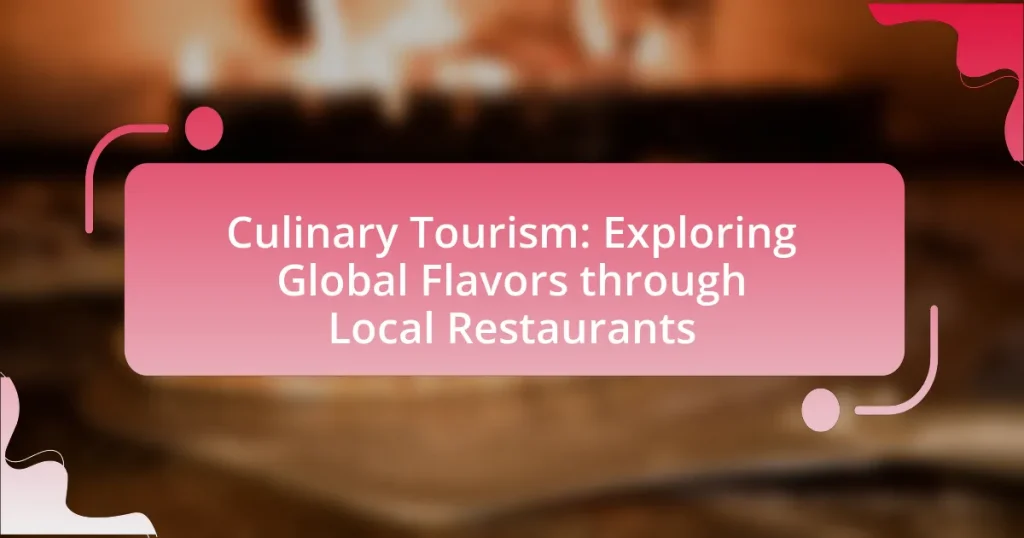Culinary tourism is defined as the exploration of food and drink as a central aspect of travel, allowing travelers to engage with local cultures through their culinary traditions. This article examines the differences between culinary tourism and traditional tourism, highlighting key elements such as local cuisine, cultural experiences, and authentic food interactions. It discusses the growing popularity of culinary tourism, the role of local restaurants in providing authentic dining experiences, and the benefits for travelers, including enhanced cultural understanding and support for local economies. Additionally, the article addresses challenges in culinary tourism, emerging trends, and best practices for travelers to fully enjoy and respect local food customs.

What is Culinary Tourism?
Culinary tourism is the exploration of food and drink as a central element of the travel experience. This form of tourism allows travelers to engage with local cultures through their culinary traditions, often involving activities such as food tastings, cooking classes, and visits to local markets. According to the World Food Travel Association, culinary tourism has grown significantly, with 93% of travelers indicating that food is an important part of their travel experience.
How does Culinary Tourism differ from traditional tourism?
Culinary tourism differs from traditional tourism primarily in its focus on food experiences rather than general sightseeing or cultural activities. While traditional tourism often emphasizes visiting landmarks, museums, and natural attractions, culinary tourism centers around exploring local cuisines, dining experiences, and food-related activities. This form of tourism engages travelers in cooking classes, food festivals, and farm-to-table experiences, allowing them to connect with local cultures through their culinary practices. According to the World Food Travel Association, culinary tourism is one of the fastest-growing sectors in the travel industry, highlighting its increasing significance in shaping travel experiences.
What are the key elements that define Culinary Tourism?
Culinary tourism is defined by key elements such as local cuisine, cultural experiences, and authentic food interactions. Local cuisine refers to the traditional dishes and ingredients unique to a region, which attract tourists seeking to experience the flavors of a destination. Cultural experiences encompass the customs, cooking techniques, and food-related traditions that provide deeper insights into a community’s heritage. Authentic food interactions involve direct engagement with local chefs, farmers, and food producers, allowing tourists to gain firsthand knowledge and appreciation of the culinary landscape. These elements collectively enhance the travel experience by connecting visitors to the local culture through its food.
Why is Culinary Tourism gaining popularity worldwide?
Culinary tourism is gaining popularity worldwide due to the increasing consumer interest in authentic food experiences and cultural immersion. Travelers are seeking unique culinary adventures that allow them to connect with local traditions and flavors, which enhances their overall travel experience. According to a report by the World Food Travel Association, 93% of travelers consider food an essential part of their travel experience, highlighting the significant role that cuisine plays in tourism. This trend is further supported by the rise of social media, where food photography and culinary experiences are widely shared, influencing others to explore diverse gastronomic offerings.
What role do local restaurants play in Culinary Tourism?
Local restaurants serve as essential hubs in culinary tourism by providing authentic regional cuisine that reflects the culture and traditions of a destination. These establishments offer tourists the opportunity to experience local flavors, ingredients, and cooking techniques, which enhances their understanding of the area’s culinary heritage. According to a study published in the Journal of Culinary Science & Technology, 70% of travelers prioritize dining experiences as a key component of their trips, indicating that local restaurants significantly influence travel decisions and satisfaction. By showcasing unique dishes and fostering connections between visitors and local communities, restaurants play a pivotal role in promoting culinary tourism and supporting the local economy.
How do local restaurants contribute to the authenticity of Culinary Tourism?
Local restaurants enhance the authenticity of culinary tourism by offering traditional dishes that reflect the region’s culture and heritage. These establishments often use locally sourced ingredients and time-honored cooking techniques, which provide tourists with a genuine taste of the area’s culinary identity. For instance, a study by the World Food Travel Association indicates that 93% of travelers consider food an essential part of their travel experience, emphasizing the importance of local cuisine in shaping their perceptions of a destination. By showcasing regional flavors and culinary practices, local restaurants play a crucial role in creating an immersive and authentic culinary tourism experience.
What types of dining experiences can travelers expect from local restaurants?
Travelers can expect a variety of dining experiences from local restaurants, including traditional cuisine, fusion dishes, farm-to-table options, and street food. Traditional cuisine showcases regional ingredients and cooking methods, allowing travelers to taste authentic flavors unique to the area. Fusion dishes combine elements from different culinary traditions, reflecting the cultural diversity of the region. Farm-to-table options emphasize fresh, locally sourced ingredients, promoting sustainability and supporting local farmers. Street food offers quick, affordable meals that often highlight local specialties and flavors, providing an immersive experience of the local culture. These dining experiences contribute to the overall culinary tourism landscape, enhancing travelers’ understanding of the destination’s food heritage.
What are the benefits of Culinary Tourism for travelers?
Culinary tourism offers travelers the benefit of immersive cultural experiences through local cuisine. Engaging with regional dishes allows travelers to connect with the history, traditions, and people of a destination, enhancing their understanding of the local culture. Additionally, culinary tourism supports local economies by promoting small businesses, such as restaurants and markets, which often rely on tourism for their livelihood. According to a report by the World Food Travel Association, 93% of travelers consider food an important part of their travel experience, indicating that culinary tourism significantly influences travel decisions and satisfaction.
How does Culinary Tourism enhance cultural understanding?
Culinary tourism enhances cultural understanding by allowing travelers to engage directly with local food traditions and practices. This immersive experience fosters appreciation for diverse culinary techniques, ingredients, and cultural significance behind dishes. For instance, participating in cooking classes or food tours enables tourists to learn about the historical and social contexts of local cuisines, thereby deepening their connection to the culture. Research indicates that food experiences can lead to greater intercultural empathy, as they encourage dialogue and interaction between locals and visitors, promoting a shared understanding of cultural values and lifestyles.
What unique experiences can travelers gain through Culinary Tourism?
Travelers can gain immersive cultural experiences through Culinary Tourism by engaging directly with local food traditions and practices. This form of tourism allows individuals to participate in cooking classes, food festivals, and farm-to-table dining, which fosters a deeper understanding of the region’s heritage and culinary techniques. For instance, travelers in Italy can learn to make traditional pasta from local chefs, while those in Thailand may participate in street food tours that highlight regional ingredients and cooking methods. Such hands-on experiences not only enhance culinary skills but also create lasting memories tied to the local culture, as evidenced by the growing popularity of culinary tours, which have increased by 30% in the last decade according to the World Food Travel Association.

How can travelers effectively engage in Culinary Tourism?
Travelers can effectively engage in Culinary Tourism by actively seeking out local dining experiences, participating in food tours, and attending cooking classes. Engaging with local chefs and food artisans enhances the understanding of regional cuisines and cultural significance. According to a study by the World Food Travel Association, 93% of travelers consider food an essential part of their travel experience, indicating that culinary activities significantly enrich their journeys. By immersing themselves in local food culture, travelers not only enjoy authentic flavors but also foster connections with the community, making their culinary tourism experience more meaningful.
What strategies can travelers use to discover local restaurants?
Travelers can discover local restaurants by utilizing online review platforms, engaging with locals, and exploring social media. Online review platforms like Yelp and TripAdvisor provide user-generated reviews and ratings, helping travelers identify popular dining spots. Engaging with locals, whether through conversations or guided tours, often leads to recommendations for hidden gems that may not be widely advertised. Additionally, social media platforms such as Instagram and Facebook allow travelers to search for trending restaurants in specific locations, often showcasing dishes and ambiance through user-generated content. These strategies leverage both technology and community insights to enhance the culinary tourism experience.
How can social media influence restaurant choices during travel?
Social media significantly influences restaurant choices during travel by providing real-time recommendations and visual content that shape travelers’ perceptions. Platforms like Instagram and Facebook allow users to share photos, reviews, and experiences, which can create a sense of urgency and desirability around specific dining options. For instance, a study by the Journal of Travel Research found that 70% of travelers are influenced by social media when selecting restaurants, highlighting its role in decision-making. Additionally, user-generated content often showcases local cuisine, making it easier for travelers to discover authentic dining experiences that align with their culinary interests.
What role do food tours play in enhancing the Culinary Tourism experience?
Food tours significantly enhance the Culinary Tourism experience by providing immersive, guided explorations of local cuisines. These tours allow participants to taste authentic dishes, learn about regional ingredients, and understand cultural cooking techniques directly from local chefs and food artisans. Research indicates that 88% of culinary tourists seek authentic experiences, and food tours cater to this demand by offering curated itineraries that highlight unique culinary traditions and local specialties. This direct engagement with food culture fosters a deeper appreciation and connection to the destination, making food tours a vital component of Culinary Tourism.
What are the challenges faced in Culinary Tourism?
Culinary tourism faces several challenges, including cultural authenticity, sustainability, and food safety. Cultural authenticity is often compromised when local cuisines are commercialized for tourists, leading to a diluted experience that does not reflect true local flavors. Sustainability issues arise as increased demand for local food can strain resources and impact local communities negatively. Food safety is another critical challenge, as tourists may encounter unfamiliar food practices that could lead to health risks. According to a study published in the Journal of Culinary Science & Technology, these challenges can significantly affect the overall experience and satisfaction of culinary tourists, highlighting the need for careful management and promotion of authentic culinary experiences.
How can travelers navigate language barriers in local dining settings?
Travelers can navigate language barriers in local dining settings by using translation apps, visual menus, and gestures. Translation apps like Google Translate allow users to communicate their food preferences and understand menu items in real-time, facilitating smoother interactions. Visual menus, which include pictures of dishes, help diners identify what they want without needing to understand the local language. Additionally, gestures can effectively convey basic requests, such as pointing to items or using universal signs for common needs. These methods have been shown to enhance dining experiences for travelers, making it easier to enjoy local cuisine despite language differences.
What are the potential risks of food safety in Culinary Tourism?
The potential risks of food safety in Culinary Tourism include foodborne illnesses, contamination, and allergen exposure. Foodborne illnesses can arise from consuming undercooked or improperly stored food, which is a significant concern in unfamiliar culinary environments. Contamination may occur due to inadequate hygiene practices by food handlers or cross-contamination between raw and cooked foods. Additionally, travelers may face allergen exposure if local cuisines contain ingredients they are unaware of, leading to severe allergic reactions. According to the World Health Organization, foodborne diseases affect an estimated 600 million people globally each year, highlighting the importance of food safety awareness in culinary tourism.

What are the emerging trends in Culinary Tourism?
Emerging trends in culinary tourism include a focus on sustainability, local sourcing, and immersive experiences. Travelers increasingly seek authentic culinary experiences that highlight regional ingredients and traditional cooking methods, reflecting a growing awareness of environmental impact and cultural preservation. For instance, a report by the World Food Travel Association indicates that 83% of travelers are interested in sustainable food practices when choosing culinary experiences. Additionally, the rise of food tours and cooking classes allows tourists to engage directly with local chefs and communities, enhancing their understanding of the culinary landscape. This trend is supported by the increasing popularity of platforms that connect travelers with local food experiences, demonstrating a shift towards personalized and meaningful culinary adventures.
How is technology shaping the future of Culinary Tourism?
Technology is significantly shaping the future of culinary tourism by enhancing the way travelers discover, experience, and share food-related activities. Digital platforms and mobile applications enable tourists to access real-time information about local dining options, food tours, and culinary events, making it easier to plan their gastronomic adventures. For instance, platforms like TripAdvisor and Yelp provide user-generated reviews and ratings, influencing dining choices and promoting local restaurants. Additionally, social media channels, particularly Instagram, allow travelers to share their culinary experiences instantly, creating a visual narrative that attracts more visitors to specific destinations. According to a report by the World Food Travel Association, 93% of travelers consider food an essential part of their travel experience, highlighting the growing importance of technology in connecting food enthusiasts with local culinary offerings.
What impact do food delivery apps have on local dining experiences?
Food delivery apps significantly alter local dining experiences by increasing convenience and accessibility for consumers. These platforms enable users to order meals from a variety of local restaurants without the need to dine in, which can lead to a decline in foot traffic for traditional dining establishments. A study by the National Restaurant Association in 2021 indicated that 60% of consumers prefer ordering food for delivery rather than dining out, highlighting a shift in consumer behavior. This trend can diminish the social aspect of dining, as fewer people gather in restaurants, potentially impacting the local culinary culture and community engagement. Additionally, restaurants may face increased competition and pressure to adapt their menus and pricing strategies to remain appealing in a delivery-centric market.
How are sustainability practices influencing Culinary Tourism?
Sustainability practices are significantly influencing culinary tourism by promoting local sourcing, reducing food waste, and enhancing the overall dining experience. These practices encourage restaurants to utilize locally grown ingredients, which not only supports local economies but also provides tourists with authentic regional flavors. For instance, a study by the World Tourism Organization indicates that 70% of travelers prefer dining experiences that emphasize sustainability, reflecting a growing demand for eco-friendly practices in the culinary sector. Additionally, restaurants that adopt sustainable practices often attract environmentally conscious tourists, thereby increasing their customer base and enhancing their reputation.
What are the best practices for enjoying Culinary Tourism?
To enjoy Culinary Tourism effectively, travelers should prioritize local dining experiences, engage with chefs and locals, and participate in food tours. Local dining experiences provide authentic flavors and cultural insights, as restaurants often use regional ingredients and traditional cooking methods. Engaging with chefs and locals enhances understanding of the culinary heritage and allows for personal stories behind the dishes. Food tours offer structured opportunities to sample diverse cuisines and learn about the history and significance of various foods in the region. These practices ensure a deeper appreciation of the culinary landscape and foster memorable experiences.
How can travelers be respectful of local food customs and traditions?
Travelers can be respectful of local food customs and traditions by researching and understanding the cultural significance of the cuisine before visiting. This includes learning about traditional dishes, dining etiquette, and any specific customs related to food preparation and consumption. For example, in many cultures, it is customary to share meals or to eat with one’s hands, which reflects communal values and hospitality. Additionally, travelers should be mindful of dietary restrictions and preferences that may be prevalent in the local culture, such as vegetarianism in India or halal practices in Muslim-majority countries. Engaging with local chefs or food guides can also enhance understanding and appreciation of these customs, fostering a deeper connection to the culinary experience.
What tips can enhance the Culinary Tourism experience for first-time travelers?
To enhance the Culinary Tourism experience for first-time travelers, it is essential to engage with local cuisine through authentic dining experiences. First-time travelers should seek out local markets and street food vendors, as these often provide the most genuine taste of a region’s culinary culture. Research indicates that 70% of travelers prefer to eat where locals eat, which enhances their understanding of the local food scene. Additionally, participating in cooking classes or food tours can deepen the appreciation for local ingredients and cooking techniques, allowing travelers to connect more intimately with the culture. Engaging with local chefs or food artisans can also provide insights into traditional recipes and cooking methods, further enriching the culinary experience.















